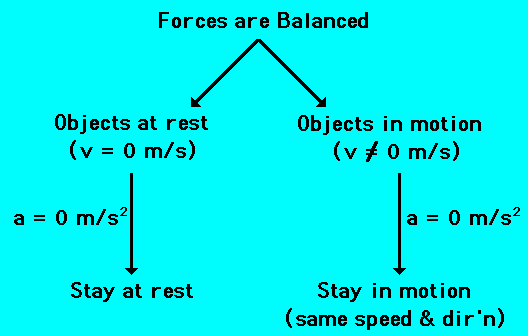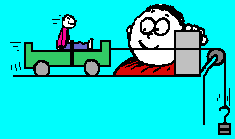Describing Motion With Words - Intro
Lesson 1: Newton's First Law of Motion
Newton's First Law
Isaac Newton (a 17th century scientist) put forth a variety of laws which explain why objects move (or don't move) as they do. These three laws have become known as Newton's three laws of motion. The focus of Lesson 1 is Newton's first law of motion - sometimes referred to as the "law of inertia."
Newton's first law of motion is often
stated as
An object at rest tends to stay at
rest and an object in motion tends to stay in motion with the same
speed and in the same direction unless
acted upon by an unbalanced force.
There are two parts to this statement - one which predicts the
behavior of stationary objects and the other which predicts the
behavior of moving objects. The two parts are summarized in the
following diagram.

 The behavior of all objects can be
described by saying that objects tend to "keep on doing what they're
doing" (unless acted upon by an
unbalanced force). If at rest, they will continue in this same
state of rest. If in motion with an eastward velocity of 5 m/s, they
will continue in this same state of motion (5 m/s, East). If in
motion with a leftward velocity of 2 m/s, they will continue in this
same state of motion (2 m/s, left). The state of motion of an object
is maintained as long as the object is not acted upon by an
unbalanced force. All objects resist changes in their state of motion
- they tend to "keep on doing what they're doing."
The behavior of all objects can be
described by saying that objects tend to "keep on doing what they're
doing" (unless acted upon by an
unbalanced force). If at rest, they will continue in this same
state of rest. If in motion with an eastward velocity of 5 m/s, they
will continue in this same state of motion (5 m/s, East). If in
motion with a leftward velocity of 2 m/s, they will continue in this
same state of motion (2 m/s, left). The state of motion of an object
is maintained as long as the object is not acted upon by an
unbalanced force. All objects resist changes in their state of motion
- they tend to "keep on doing what they're doing."
There are many applications of Newton's first law of motion.
Consider some of your experiences in an automobile. Have you ever
observed the behavior of coffee in a coffee cup filled to the rim
while starting a car from rest or while bringing a car to rest from a
state of motion? Coffee tends to "keep on doing what it is doing."
When you accelerate a car from rest, the road provides an unbalanced
force on the spinning wheels to push the car forward; yet the coffee
(which was at rest) wants to stay at rest. While the car accelerates
forward, the coffee remains in the same position; subsequently, the
car accelerates out from under the coffee and the coffee spills in
your lap. On the other hand, when braking from a state of motion the
coffee continues forward with the same speed and in the same
direction, ultimately hitting the windshield or the dash. Coffee
in motion tends to stay in motion.
 Have you ever experienced inertia
(resisting changes in your state of motion) in an automobile while it
is braking to a stop? The force of the road on the locked wheels
provides the unbalanced force to change the car's state of motion,
yet there is no unbalanced force to change your own state of motion.
Thus, you continue in motion, sliding along the seat in forward
motion. A person in motion tends to stay in motion with the same
speed and in the same direction ... unless
acted upon by the unbalanced force
of a seat belt. Yes, seat belts are used to provide safety for
passengers whose motion is governed by Newton's laws. The seat belt
provides the unbalanced force which brings you from a state of motion
to a state of rest. Perhaps you could speculate what would occur when
no seat belt is used.
Have you ever experienced inertia
(resisting changes in your state of motion) in an automobile while it
is braking to a stop? The force of the road on the locked wheels
provides the unbalanced force to change the car's state of motion,
yet there is no unbalanced force to change your own state of motion.
Thus, you continue in motion, sliding along the seat in forward
motion. A person in motion tends to stay in motion with the same
speed and in the same direction ... unless
acted upon by the unbalanced force
of a seat belt. Yes, seat belts are used to provide safety for
passengers whose motion is governed by Newton's laws. The seat belt
provides the unbalanced force which brings you from a state of motion
to a state of rest. Perhaps you could speculate what would occur when
no seat belt is used.

 There are many more applications of
Newton's first law of motion. Several applications are listed below -
it is hoped that you could provide explanations for each
application.
There are many more applications of
Newton's first law of motion. Several applications are listed below -
it is hoped that you could provide explanations for each
application.
- blood rushes from your head to your feet while quickly
stopping when riding on a descending elevator.
- the head of a hammer can be tightened onto the wooden
handle by banging the bottom of the handle against a hard
surface.
- a brick is painlessly broken over the hand of a gullible
father by slamming it with a hammer. (CAUTION: do not attempt
this at home!)
- to dislodge ketchup from the bottom of a ketchup bottle, it
is often turned upside down and, thrusted downward at high speeds
and then abruptly halted.
- headrests are placed in cars to prevent whiplash injuries
during rear-end collisions.
- while riding a skateboard (or wagon or bicylce), you fly
forward off the board when hitting a curb or rock or other object
which abruptly halts the motion of the skateboard.
Mr.Tracy is the best teacher in the world, his lessons are always fun and entertaining. He is the best damned teacher anyone could ever ask for; yes, he certainly is a living legend in our midst! (hope that pays off!)



Lesson 1: Newton's First Law of Motion


 The behavior of all objects can be
described by saying that objects tend to "keep on doing what they're
doing" (unless acted upon by an
unbalanced force). If at rest, they will continue in this same
state of rest. If in motion with an eastward velocity of 5 m/s, they
will continue in this same state of motion (5 m/s, East). If in
motion with a leftward velocity of 2 m/s, they will continue in this
same state of motion (2 m/s, left). The state of motion of an object
is maintained as long as the object is not acted upon by an
unbalanced force. All objects resist changes in their state of motion
- they tend to "keep on doing what they're doing."
The behavior of all objects can be
described by saying that objects tend to "keep on doing what they're
doing" (unless acted upon by an
unbalanced force). If at rest, they will continue in this same
state of rest. If in motion with an eastward velocity of 5 m/s, they
will continue in this same state of motion (5 m/s, East). If in
motion with a leftward velocity of 2 m/s, they will continue in this
same state of motion (2 m/s, left). The state of motion of an object
is maintained as long as the object is not acted upon by an
unbalanced force. All objects resist changes in their state of motion
- they tend to "keep on doing what they're doing." Have you ever experienced inertia
(resisting changes in your state of motion) in an automobile while it
is braking to a stop? The force of the road on the locked wheels
provides the unbalanced force to change the car's state of motion,
yet there is no unbalanced force to change your own state of motion.
Thus, you continue in motion, sliding along the seat in forward
motion. A person in motion tends to stay in motion with the same
speed and in the same direction ... unless
acted upon by the unbalanced force
of a seat belt. Yes, seat belts are used to provide safety for
passengers whose motion is governed by Newton's laws. The seat belt
provides the unbalanced force which brings you from a state of motion
to a state of rest. Perhaps you could speculate what would occur when
no seat belt is used.
Have you ever experienced inertia
(resisting changes in your state of motion) in an automobile while it
is braking to a stop? The force of the road on the locked wheels
provides the unbalanced force to change the car's state of motion,
yet there is no unbalanced force to change your own state of motion.
Thus, you continue in motion, sliding along the seat in forward
motion. A person in motion tends to stay in motion with the same
speed and in the same direction ... unless
acted upon by the unbalanced force
of a seat belt. Yes, seat belts are used to provide safety for
passengers whose motion is governed by Newton's laws. The seat belt
provides the unbalanced force which brings you from a state of motion
to a state of rest. Perhaps you could speculate what would occur when
no seat belt is used. There are many more applications of
Newton's first law of motion. Several applications are listed below -
it is hoped that you could provide explanations for each
application.
There are many more applications of
Newton's first law of motion. Several applications are listed below -
it is hoped that you could provide explanations for each
application.
